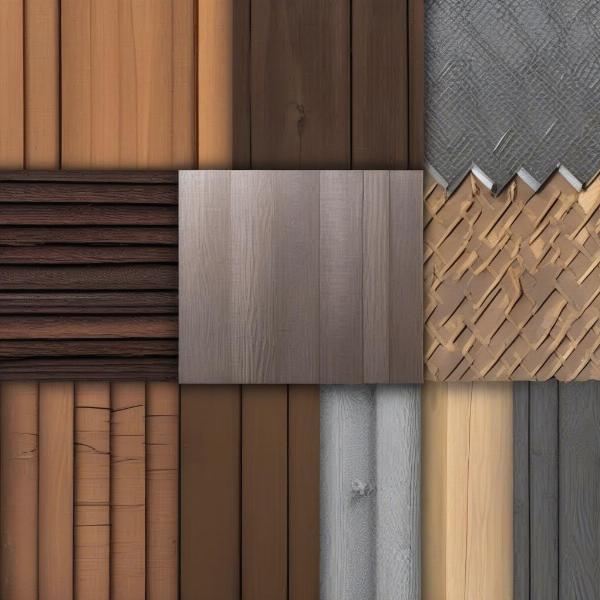Choosing the right fence barrier for your dog is a crucial decision for any responsible pet owner. It ensures their safety, prevents escapes, and provides a secure space for them to play and relax. Whether you have a tiny Chihuahua or a boisterous Great Dane, understanding the different types of fence barriers, their pros and cons, and installation tips will help you create the perfect enclosure for your furry friend. This guide explores everything you need to know about fence barriers for dogs, from choosing the right materials and height to considering your dog’s breed and temperament.
Choosing the Right Fence Barrier for Your Dog’s Needs
Several factors influence the choice of the ideal fence for your canine companion. Breed, size, temperament, and your local environment all play a role. A small, docile dog might be content with a shorter fence, while a larger, more energetic breed might require a taller, more robust barrier. Understanding your dog’s specific needs is the first step to selecting the right enclosure.
What if my dog is a known escape artist? Consider a solid fence that prevents them from seeing through and potentially becoming tempted to escape. This can also help reduce barking triggered by passing sights and sounds. Alternatively, if your dog is relatively calm, an open-style fence might be suitable, allowing them to observe their surroundings.
Fence Materials: A Detailed Overview
From traditional wood to modern vinyl, various fence materials are available, each with its own set of advantages and disadvantages. Wood offers a classic aesthetic but requires regular maintenance. Vinyl is low-maintenance but can be more expensive. Chain-link is affordable and durable but doesn’t offer much privacy. Metal fences provide a robust barrier, but some dogs might attempt to climb them. Consider the following options:
- Wood: Classic look, requires staining and sealing.
- Vinyl: Durable, low-maintenance, more expensive.
- Chain-link: Affordable, doesn’t offer privacy.
- Metal: Strong, can be climbed by some dogs.
 Fence Materials Overview
Fence Materials Overview
Choosing the right material is essential for both aesthetics and practicality. Think about your budget, maintenance preferences, and the overall look you want to achieve.
Fence Height and Installation
Fence height is crucial for containing your dog. A general rule of thumb is that the fence should be at least twice the height of your dog when standing on their hind legs. However, for known jumpers, you might need to consider even taller options or add extensions to prevent escapes. [how to keep my dog from jumping over the fence](https://ilmdog.com/how-to keep-my-dog-from-jumping-over-the-fence.html) offers further tips on preventing fence jumping. Proper installation is also vital to ensure the fence is secure and stable.
How do I install a dog fence correctly?
Ensure the fence posts are deeply and securely set in the ground, especially in areas with frost lines. The fence panels should be tightly attached to the posts to prevent gaps or weak points. Consider professional installation for complex fence designs or if you lack experience.
Maintaining Your Dog Fence
Regular maintenance keeps your fence looking good and functioning effectively. Wood fences need periodic staining and sealing to protect against weather damage. Vinyl fences require occasional cleaning, while metal fences should be inspected for rust and corrosion. Regularly check for any loose boards, panels, or gaps that could compromise your dog’s safety. garden dog fence can offer additional insights into maintaining various fence types.
Creating a Safe and Engaging Environment Within the Fence
Once your fence is installed, consider ways to create a stimulating environment within the enclosed space. Provide toys, a comfortable dog house, and access to shade and water. Consider designated areas for potty breaks and play. A stimulating environment prevents boredom and helps your dog feel comfortable and happy in their designated space. For temporary fencing solutions, refer to temporary garden fencing dogs. If you’re concerned about dogs entering specific areas of your home, a shock gate for dogs may be a solution.
Conclusion
Choosing the right fence barrier for your dog is an investment in their safety and well-being. By considering your dog’s individual needs, exploring different materials and heights, and ensuring proper installation and maintenance, you can create a secure and enjoyable space for your furry companion to thrive.
FAQ
- What is the best fence height for a large dog? Generally, a fence of at least 6 feet is recommended for large breeds.
- What is the most low-maintenance fence material? Vinyl is generally considered the most low-maintenance fencing material.
- How do I stop my dog from digging under the fence? Bury chicken wire or install concrete footers along the fence line.
- What is the best fence for a dog that likes to climb? Solid fences or fences with inward-leaning tops can deter climbers.
- Can I use an invisible fence for my dog? Invisible fences can be effective for some dogs, but not all.
- How can I make my fence more secure for my dog? Regular inspections and maintenance are key to ensuring fence security.
- Are there any regulations regarding dog fences in my area? Check with your local authorities for specific regulations.
ILM Dog is a leading international website dedicated to providing expert advice on dog care and wellbeing. We offer comprehensive information on various topics, including breed selection, health care, training, nutrition, grooming, and product recommendations. Our mission is to empower dog owners worldwide with the knowledge and resources they need to provide the best possible care for their canine companions. Need expert advice? Contact us at [email protected] or call us at +44 20-3965-8624. ILM Dog is your trusted source for all things dog-related!